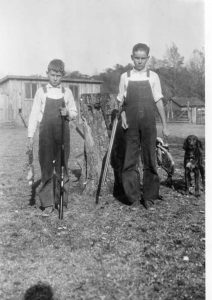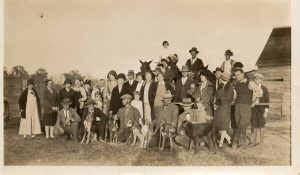



 Hunting for quail, squirrels, rabbits, ducks, “Canadian Honkers” (Canada geese) and trapping for muskrats was a form or recreation, plus trapping put a little spending money in your pocket. Just about every young man in the village had a succession of guns which normally started with a BB gun and then a 22 rifle followed by a shotgun of some gauge. Hunting in the early days was always a means of getting a meal or two while being a sport about it. Hunting dogs were household pets for most families and when not being a pet they were acting as scouts for quail. Once they smelled them they would stand until the birds were flushed out by the hunter. If you were on the water the pets would be retrieving ducks and geese from the frigid waters of the lakes and creeks in the area. Most of the land was not posted, but you always asked the land owner if you could hunt the property and without fail permission was given. Soy bean fields were great for quail hunting and corn fields attracted the geese early in the morning or late afternoon just before dark. Most ducks were killed from blinds built on the water or near water’s edge with decoys to attract the ducks to fly in to join a group not knowing that they were not alive. Shelton Rountree, the game warden, who we all knew, was fair and true to his job. He was respected and when he asked for your license you best have it with you. Birds would be counted as well as ducks and geese to make sure you were within the limits.
Hunting for quail, squirrels, rabbits, ducks, “Canadian Honkers” (Canada geese) and trapping for muskrats was a form or recreation, plus trapping put a little spending money in your pocket. Just about every young man in the village had a succession of guns which normally started with a BB gun and then a 22 rifle followed by a shotgun of some gauge. Hunting in the early days was always a means of getting a meal or two while being a sport about it. Hunting dogs were household pets for most families and when not being a pet they were acting as scouts for quail. Once they smelled them they would stand until the birds were flushed out by the hunter. If you were on the water the pets would be retrieving ducks and geese from the frigid waters of the lakes and creeks in the area. Most of the land was not posted, but you always asked the land owner if you could hunt the property and without fail permission was given. Soy bean fields were great for quail hunting and corn fields attracted the geese early in the morning or late afternoon just before dark. Most ducks were killed from blinds built on the water or near water’s edge with decoys to attract the ducks to fly in to join a group not knowing that they were not alive. Shelton Rountree, the game warden, who we all knew, was fair and true to his job. He was respected and when he asked for your license you best have it with you. Birds would be counted as well as ducks and geese to make sure you were within the limits.
Muskrats were plentiful in the area and a pelt would bring anywhere from $2.00-$3.00 depending on the condition. The meat was a delicacy wanted by many of the African Americans in the area so it was no problem to have it taken off your hands. Sam Chapman in Sandy Bottom and Raymond Butler at Reid’s Ferry would buy the pelts from the locals and sell them to a buyer from Norfolk. The meat could also be distributed by Mr. Chapman if it made it that far without falling into the hands of some of the farm workers.
Fishing in Crump’s mill pond and the marl pits, now known as Lone Star Lakes, were excellent sources for local fisherman. Add to these Burnt Mill, Lake Prince and Western Branch reservoirs and you have hundreds of acres of good all weather/season fishing. The lakes hold a variety of fresh water fish with the most treasured being the large mouth bass, crappie, chain pickerel, bluegill, redear sunfish, white perch and yellow perch, just to name a few. Fly casting and bamboo poles remain the two most prevalent types of fishing equipment. If you wanted a great time go to the “Duck Hole”, at the top end of the Chuckatuck Creek, very close to the grist mill where you have brackish water and you can add some salt water fish to that list like stripped bass, croakers and catfish.
There was some type of outdoor recreational activity year round within the GCH area and in the early days you only needed to “just do it” as no license was required as it is today. Still there are lots of activities that you can do at your leisure and fairly inexpensively.
